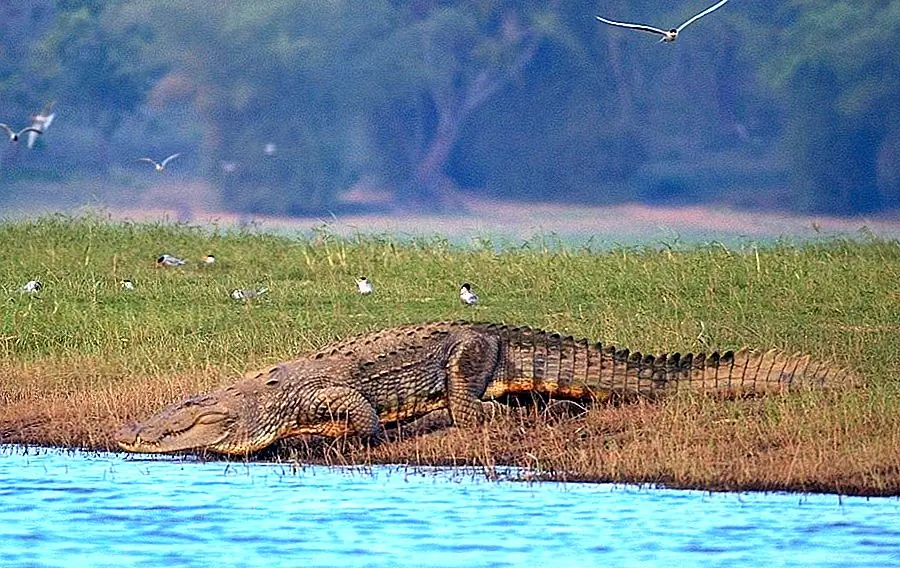Traveling by bus from Bengaluru for a trip to Nagarhole National Park, we stopped at the forest check post when we reached the Park where the driver and forest guard greeted each other. The driver cautiously asked if elephants had been sighted on the main road that day. His tension visibly eased when he received a negative answer.
Majestic teak trees towered over us, and I became aware that the forest was silent before the bus noise. The silence was broken every now and then by the raucous call of a peacock, or by the cackling of the junglefowl. After freshening up in the simple but clean Forest Department retirement home, I opted for a jeep ride through the forest. There is a well-defined network of roads in the forest, good for the tourist, but potentially disturbing for the animals. The department maintains ‘sight lines’, 10 m long areas along both sides of the road, where brush and trees are cleared for an unfettered view of the wildlife.
These spots, usually created by burning the plants, also attract animals – fresh grass sprouts in these areas, which function as magnets for the wildlife. It helps that the terrain in Nagarhole is mostly flat; visibility is high. Saw a few herds of cheetal and troops of langurs as soon as we started the ride. Driving along the winding forest roads, our group encountered a large herd of Gaur grazing and browsing in a gap near a ‘line of sight’.
Read also: Orange County Resort
Leopards Ahoy!
As we made a sharp turn, we heard a faint sawing sound – a mixture of a rasp and a cough, the clear call of the leopard. Immediately we heard the alarm calls of langurs. Holding our collective breaths and cameras, we waited. Soon a leopard and two cubs hit the road. The leopard saw us and indignantly sauntered down the road into the jungle. The cubs lingered, curious. But they also ran to the other side and wanted to stay close to their mother. On the way back we saw a herd of elephants grazing. As the light was fading quickly our driver was not happy to see them – elephants have poor eyesight and are known to charge the vehicles. However, these were not interested in us. Back at camp, after a hot bath, I enjoyed a simple, substantial meal and watched some wildlife videos at the camp’s Wildlife Interpretation Center.

Enter the king
The next morning we left the camp at dawn, with great hope on our faces. It was a beautiful foggy morning. We saw a herd of Sambar cautiously browsing along the side of the road. Suddenly they looked around frantically and returned to their meal. Nearby we heard the screeching of the viper in the crest. Looking closer, I saw that there was a small snake in its claws. It was breakfast in Nagarhole National Park! We slowed down as we approached a waterhole: this spot is said to be a favorite with tigers. While waiting I spoke to our driver Bomma and asked him if he had seen any tigers this month. After thinking for no less than five minutes, he told me he had seen them every day except the previous Saturday and Sunday! Bomma got impatient after waiting for a while and suggested we go elsewhere. I was visiting in October and there was a lot of water everywhere. The chance of seeing a tiger at a waterhole is higher in summer. The sun’s rays grew stronger and the birds more active. Woodpeckers, drongos, tree pies and orioles flew by in an amazing riot of color. Suddenly the forest became silent and we heard the cry of a sambar. After that alarm call, other animals started theirs too — there was the langur’s whoop-whoop and the cheetal’s high-pitched scream, among others. We waited with bated breath and suddenly saw the huge head of a tiger peeping out of thick lantana bushes. People have often commented on how larger than life the tiger actually looks. It is a big cat, but one realizes how big only after seeing one. It stared at us for a while, then let out a low growl as it crossed the road, disappearing from our sight.
The park
One of the oldest national parks in India, Nagarhole (‘Serpent River’) was once maintained as a hunting ground for the Mysore royal family. The NP was established in 1955. The Forest Department built retirement homes and other facilities in the park. The boundaries were expanded to the current area of 645 square km in 1974. It was renamed after Rajiv Gandhi in 1992.

Place
Nagarhole NP is spread across the districts of Mysore and Kodagu and is bounded by the Kabini River to the south, the Wayanad WLS to the southwest and the Bandipur Tiger Reserve to the southeast.
The distance
95 km ten ZW van Mysore, 222 km ten ZW van Bengaluru.
Itinerary from Bengaluru
SH17 naar Srirangapatna via Maddur; bypass naar Coorg via Ranganathittu; SH88 naar Hunsur; provincial wegen naar Nagarhole via Veeranahosahalli en Murkal.
When to go
The best period to visit is from October to March.
Park sometimes closes, for safaris, in March-April.
Go there for elephants, tigers, leopards, dhole, gaur, sambar.
Wildlife/Forest Dept offices
Read also:





